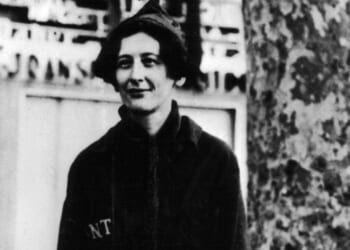(LifeSiteNews) — The headline for The Cut’s feature on October 3 was a stark challenge: “The Best Doctors Are Abortion Providers.” Which, to my ears, is rather like saying: “The Best Chefs are Cannibals.”
The 2,500-word piece is a chapter from Irin Carmon’s forthcoming book Unbearable, a history that purports to detail “what’s gone wrong with pregnancy in America,” especially for those don’t want to be pregnant. Carmon is a writer for New York Magazine and author of The Notorious RBG, a biography of the primary abortion champion on the U.S. Supreme Court, the late Ruth Bader Ginsburg.
Carmon has covered the abortion beat for years, and she notes that as a result “some jadedness had set in.” It surfaced when she was getting a 32-week ultrasound four days after the Supreme Court overturned Roe v. Wade, when she saw her second child on the sonogram monitor, a “shockingly clear delineation: an upturned nose and pouting lips hanging open.”
“She’s looking more like a person now,” Carmon told her husband. The ultrasound tech responded by saying, toward the screen: “You were a person from day one.” Carmon writes that this “was probably the most explicit moment during my two pregnancies of being treated, by a medical provider, like an incubator rather than a person.”
In other words, the affirmation of her pre-born child’s personhood, to Carmon, was a deliberate revocation of her own. That is abortion ideology in a nutshell: A zero-sum game in which the mother and child are fundamentally at odds.
Carmon tells that story in service of her primary narrative: That abortionists are just better doctors than everyone else. Over more than a decade, she writes, she had “spent countless hours with abortion providers — people I considered heroes, who’d risked their careers and even their safety in increasingly hostile environments.”
Carmon cites plenty of grim and ugly problems with the health care system, to be sure. Standards of patient care vary from physician to physician, and some of her stories — such as how she was treated when giving birth to her first child — are hair-raising. Many of those examples involve women being treated like “animals” while they are pregnant, and many of her diagnoses are obviously correct.
Carmon’s body of work, however, rests on a false premise: That when medical professionals are dealing with a pregnant woman, they are dealing with one patient rather than two. The key offense for Carmon — the one she leads with — is that many medical professionals treat the pre-born child like a human being with the right not to be killed.
One of the incidents she cites highlights this. A young woman named Maggie, who had nearly died in childbirth previously, went to Planned Parenthood for an abortion. The counselor allayed her concerns about the procedure:
She walked Maggie through all the potential risks but also statistics showing that abortion is much safer than giving birth. The most commonly cited data says that abortion is 14 times safer; a more recent analysis suggests that terminating a pregnancy is at least 30 times safer than staying pregnant … The abortion had been, (Maggie) said, “the best prenatal care I’ve had.”
It is clearly sinister to refer to abortion as “prenatal care” — literally, “before birth” care — as if the child in the womb is being cared for rather than dismembered, suctioned, or poisoned to death. Carmon treats the story of abortion as if there were only two characters: the woman and the medical professional. But, of course, there is a third character in this story. In Carmon’s narrative, the pre-born child is not just a non-person but virtually invisible. Indeed, sometimes ludicrously so. She writes:
Roe’s effect was revolutionary, but its reasoning, notably crafted by moderate Republicans with deep respect for the Establishment, was not. “Roe v. Wade was as much about a doctor’s right to practice his profession as he sees fit,” Ruth Bader Ginsburg told me in 2015, as it was about the right of a woman to control her body. “And the image was the doctor and a little woman standing together. We never saw the woman alone.”
We also never see the baby. Ginsburg, too, apparently regards the pre-born child — the reason, it must be pointed out, for the entire debate — as a non-entity. Carmon emphasizes that “Pregnancy is not just a medical condition but a profound life experience touching on a person’s deepest values, dreams, and fears.” But the technical definition of pregnancy is more enlightening: “Pregnancy is the term used to describe the period in which a fetus develops inside a woman’s womb or uterus.” Who is the fetus? Apparently, she doesn’t matter.
Carmon’s conclusion is almost farcical: “All reproductive healthcare providers should learn from those who perform abortions: The pregnant person is the protagonist of their own story, not a supporting character.” But she doesn’t even give the fetus — Latin for “young one,” incidentally — the role of a supporting character, because to admit that she is a character at all would bring up the question of the baby’s moral status. And if she were to do that, the entire premise upon which her argument rests would promptly collapse.
Carmon’s lionization of abortionists reminded me of the conversations exposed by undercover investigator David Daleiden of the Center for Medical Progress. Dr. Lisa Harris telling a laughing audience about dealing with “the heads (of the babies) that get stuck that we can’t get out.” Dr. Uta Landy getting appreciative chuckles when she mentioned getting grossed out during an abortion when an “eyeball fell on my lap.” Dr. Deborah Nucatola explaining that they kept baby heads separate after abortions for the customers who wanted to purchase brains.
Or Dr. Ann Schutt-Aine, director of abortion services at Planned Parenthood Gulf Coast, describing how she dodges the laws on partial-birth abortion (PBA): “If I’m doing a procedure, and I see that I’m in fear that’s it about to come past the umbilicus (navel), I might ask for a second set of forceps to hold the body at the cervix and pull off a leg or two so it’s not a PBA.”
And another abortionist saying: “Let’s just give them all the violence, it’s a person, it’s killing. Let’s just give them all that. And then the more compelling question is, ‘So, why is this the most important thing I could do with my life?’”
In a 2021 essay in the Boston Review titled “Why I Provide Abortions,” Christine Henneberg described how this “care” looks on an average day in the clinic. She related an anecdote of performing an abortion with the assistance of a pregnant staffer, Jenny:
Later that afternoon, Jenny assists me during a 15-week procedure. The fetus on the ultrasound screen looks just like Jenny’s, in every recognizable, perfectly formed detail: fingers, toes, beating heart. But this image is very different because of the context in which I am viewing it.
The woman is lying on the table, awake but sedated by medications. I dilate her cervix and place a small plastic tube inside her uterus. I watch the ultrasound screen. I flip a switch; a humming noise fills the room. At this instant, the fetus seems to jump as though startled; then it squirms in the tight, already shrinking space of the uterus. It continues to move in this very human, baby-like way until the last instant, when it is overpowered by the force of the vacuum and sucked through a plastic tube, whisked out of the uterus and into a glass jar in in a rush of blood. Gone.
Gone. But first, she existed. She jumped; she squirmed; she tried to get away. Then, she was suctioned into bloody slurry. Throughout the book excerpt published by The Cut, Carmon can pretend the baby isn’t there by writing around her. Abortionists don’t have that luxury — because their job is to get rid of her.


















